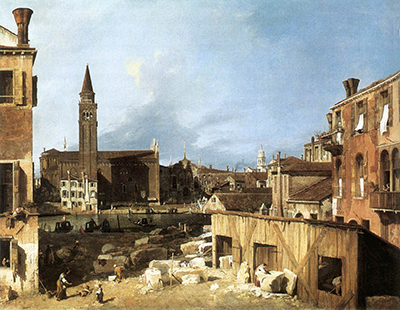The Stonemason's Yard is an oil on canvas painting executed between 1725 and 1727. The painting measures 49 by 64 inches. By 1808, The Stonemason's Yard was in Sir George Beaumont's collection. It was one of the artworks Sir George donated in 1823 to the British Museum to form the foundation of the nascent collection of the National Gallery.
In 1828, the painting was moved to the National Gallery, where it's currently exhibited. It's believed that the artist painted the informal scene for a Venetian patron. The Stonemason's Yard depicts a Venetian informal scene looking southwest over a temporary yard owned by a stonemason. The yard is positioned in an open space next to the Grand Canal called the Campo San Vidal.
Several mansions are working, shaping and carving stone to be used in the reconstruction of the San Vidal church or the embellishment of a palazzo. The painting shows scenes of everyday life in Venice, Italy in the early morning. The sunlight is streaming in from the left side behind the viewer's east and a c*ck is crowing on a windowsill situated to the lower left side.
The largely domestic buildings are in poor repair, with normal Venetian flared chimney-pots. Potted plants are standing on several balconies and laundry is hanging from many windows. There is a woman who is drawing water from a well located in the campo next to a wooden shed. On one of the balconies positioned to the right, another woman is spinning thread with a distaff and drop spindle.
In front of the painting - to the left of the viewer - two children are playing. One kid is falling over and discharging urine involuntarily in surprise, while a woman lunges forward trying to catch him. There is a woman at a nearby balcony looking down.
A gondola that has a canopied cabin is passing on the canal, with other gondolas moored on either bank. The side of Santa Maria della Carità, a medieval church reconstructed in the 1440s, is standing on the opposite of the Grand Canal bank, to the left side of the Scuola Grande della Carita facade.
In the distance, the tower of San Trovaso church is seen rising over the rooftops. The painting combines features of the artist's early, mature styles. For instance, in the use of 2 under colours. Amongst other pigments that Canaletto used in this painting were ochres, lead white and Naples yellow.




